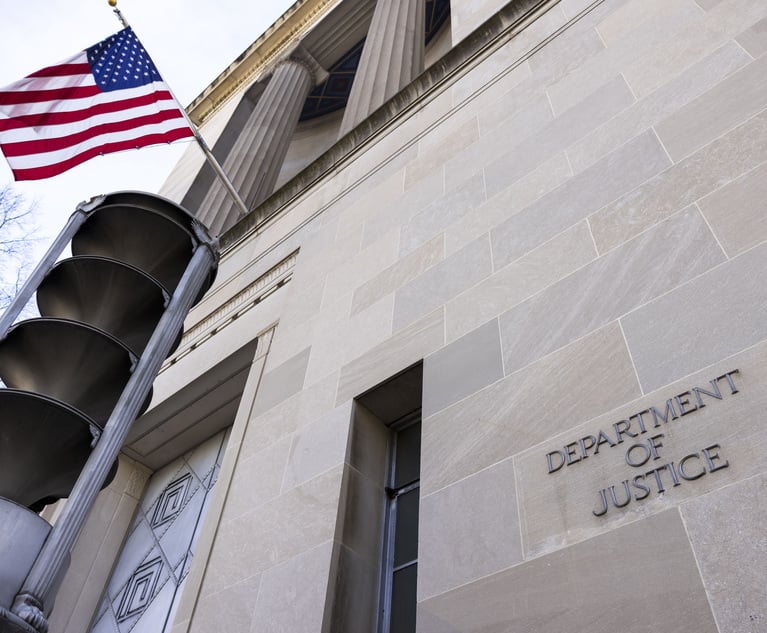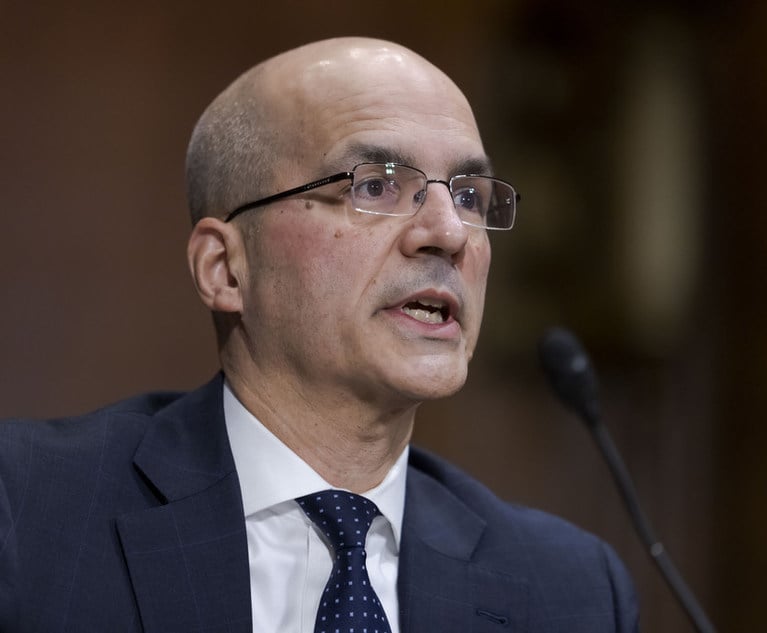CPLR 5513(a): Whose Service of the Order or Judgment Starts the 30-Day Limitation Period?
While many post-amendment cases track the language in §5513 that a “notice of appeal must be filed and served within 30 days after service by a party of the order and written notice of entry,” diligent research revealed no direct post-amendment case law on this specific point.
February 04, 2019 at 02:30 PM
10 minute read
 From at least 1858 (Dobess Realty v. City of New York, 79 A.D.2d 348, 352 (1st Dep't 1981)) to Jan. 1, 1997, case law held that “CPLR 5513(a) limit[ed] the time to appeal by requiring that an appeal as of right 'be taken within thirty days after service upon the appellant of a copy of the judgment or order appealed from and written notice of its entry.'” Williams v. Forbes, 157 A.D.2d 837, 838 (2d Dep't 1990). Although then “CPLR 5513 did not explicitly designate the person who must serve the order or judgment being appealed from for purposes of commencing the 30-day limitation period running” in cases involving multiple parties (Williams, at 838-39), “5513 [wa]s construed to require each prevailing party to separately serve an order with notice of entry to commence the running of time within which the appeal limitations period became effective for each.” Blank v. Schafrann, 206 A.D.2d 771, 773 (3d Dep't 1994); Williams, at 838-39.
From at least 1858 (Dobess Realty v. City of New York, 79 A.D.2d 348, 352 (1st Dep't 1981)) to Jan. 1, 1997, case law held that “CPLR 5513(a) limit[ed] the time to appeal by requiring that an appeal as of right 'be taken within thirty days after service upon the appellant of a copy of the judgment or order appealed from and written notice of its entry.'” Williams v. Forbes, 157 A.D.2d 837, 838 (2d Dep't 1990). Although then “CPLR 5513 did not explicitly designate the person who must serve the order or judgment being appealed from for purposes of commencing the 30-day limitation period running” in cases involving multiple parties (Williams, at 838-39), “5513 [wa]s construed to require each prevailing party to separately serve an order with notice of entry to commence the running of time within which the appeal limitations period became effective for each.” Blank v. Schafrann, 206 A.D.2d 771, 773 (3d Dep't 1994); Williams, at 838-39.
In 1996, CPLR 5513(a) was amended, (L.1996, c. 214, §1), effective Jan. 1, 1997, to provide: “An appeal as of right must be taken within thirty days after service by a party upon the appellant of a copy of the judgment or order appealed from and written notice of its entry … .” The statute still does not identify who needs to effect service in instances involving multiple parties—must it still be the prevailing party or is service by any party sufficient as long as the respondent has been properly made aware? While many post-amendment cases track the language in §5513 that a “notice of appeal must be filed and served within 30 days after service by a party of the order and written notice of entry,” diligent research revealed no direct post-amendment case law on this specific point.
Statutes Regulating the Right to Appeal Are Strictly Construed
Statutes which regulate the right to appeal are traditionally accorded a strict construction (Austin & Co. v. H.D. Reichert Const., 151 A.D.2d 851, 852 (3d Dep't 1989); Reynolds v. Dustman, 1 N.Y.3d 559, 560 (2003)), so as not to deprive a defeated party of his right to appeal. In re Downey's Will, 275 A.D. 1008, 1008 (3d Dep't 1949); see also Livingston v. New York El. R. Co., 15 NYS 191, 192 (NY Gen. Term 1891). The party seeking to limit the time of another to take an appeal must be held strictly to the rules of practice; failure to comply therewith may not be overlooked. Nagin v. Long Is. Sav. Bank, 94 A.D.2d 710 (2d Dep't 1983), lv. Den. 63 N.Y.2d 603 (1984).
Pre-Amendment Case Law Involving Multiple Parties
Williams, above, held that since Williams never served a copy of the order with notice of entry upon Forbes prior to Forbes' filing his notice of appeal, Forbes's appeal was therefore timely. Service of the order upon Forbes by another defendant was not effective to commence the running of the 30-day limitation clock.
The plaintiff, in Maddox v. City of New York, 104 A.D.2d 430 (2d Dep't 1984), moved to dismiss the appeal by the City of New York for untimeliness. As in Farrell v. Stafford Mach., 205 A.D.2d 951 (3d Dep't 1994), below, another defendant had served the order with notice of entry upon all of the parties, including the City. Plaintiffs, however, failed to serve the appellant-City. The City served and filed a notice of appeal more than 35 days after the codefendant had served a copy of the order. Here, too, “the plaintiff's motion to dismiss the City's appeal was denied pursuant to the principle, developed in case law, that a party who is moving to dismiss an adversary's appeal as untimely must have served upon that appellant a copy of the order or judgment appealed from, together with notice of its entry, in order to start the 30-day limitations period running.”
Farrell similarly rejected the contention of an untimely appeal where the judgment had been served on the defendants by plaintiffs' attorneys, rather than by the attorneys for defendant-SMX for which reason the service was not effective to commence the running of the time within which to take an appeal.
In O'Brien v. City of New York, 6 A.D.2d 63 (1st Dep't 1958), judgment was entered, on Jan. 17, 1956, in favor of the plaintiff and dismissing the cross-complaint of defendant-appellant City of New York against defendant-respondent WFE. On Jan. 26, 1956, the plaintiff served a copy of the judgment with notice of entry upon the City. WFE, however, failed to serve the City. On Feb. 7, 1958, the City served a notice of appeal from that portion of the judgment dismissing its cross-complaint against WFE.
WFE moved to dismiss the City's appeal on the grounds of untimeliness because the service of the notice of entry of judgment made by the plaintiff started running the statutory limitation of time in the Civil Practice Act 612 against NYC's right to appeal “within thirty days after service upon the attorney for the appellant of a copy of the judgment or order appealed from and a written notice of the entry thereof …” (emphasis added). The Appellate Division held that “[WFE] may not avail himself of the judgment and notice of entry served by the plaintiff.”
O'Brien further underscored that when a defendant seeks to appeal against a codefendant, “said defendant's time to appeal does not start to run until 30 days after service upon him of notice of entry of the judgment by the prevailing codefendant.”
The First Department also opined that since the City had already been served by the plaintiff it is “illogical to require, for appeal purposes, a notice of judgment to be served upon a party twice, merely because his appeal is against a codefendent.” The court concluded that, the absence of logic notwithstanding, correction rests exclusively with the Legislature.
Mancini v. Mormile, 229 A.D.2d 542 (2d Dep't 1996), arose from the Family Court. Then Family Court Act §1113 provided that an appeal “must be taken no later than thirty days after the service upon the appellant of any order from which the appeal is taken” (emphasis provided).
The Second Department analogized Family Court Act (FCA) §1113 with the other civil cases ruling that “[a]lthough the statute does not so state, the long-standing rule applied with respect to FCA §1113 and other similarly-worded statutes is that in order to start the limitation period running, service of the order from which the appeal is taken must be made by the prevailing party.”
The Memorandum of the Bill Sponsor to the Amendment
The Memorandum of the Bill Sponsor (A10407) notes that the amendment was “introduced at the request of the Chief Administrative Judge upon the recommendation of his Advisory Committee on Civil Practice” “to clarify [the ambiguity in the statute] that only the requisite notice of entry of judgment given by a party to the other parties in litigation is effective to trigger the time allowed the latter to commence an appeal.” However, the Memorandum made no recommendation or even mention as to who must effect service in instances involving multiple parties:
Currently there is an ambiguity because, in practice, some judges upon rendering a judgment or order, undertake themselves to file the original papers in the County Clerk's office and notify parties of the filing—understanding that this filing triggers the 30-day appeal period. Other judges, who also file the papers with the County Clerk and notify the parties of their filing, specifically advise that their notification does not trigger the 30-day period. Still other judges return the original papers to the parties, leaving to them the task of entry with the County Clerk.
The proposed amendment clarifies the ambiguity surrounding these varied practices by inserting service “by a party”, to make it unmistakably clear that service upon a party of notice of the entry of judgment by a Clerk or Court would not constitute service of notice of such entry for purposes of triggering the time to take an appeal as of right under CPLR 5513(a).
The New York State Bar Association Legislation Report
The New York State Bar Association, Legislation Report, Committee on Civil Practice Laws and Rules, Report No. 268, June 4, 1996, in the Bill Jacket, mirrored the concern expressed by the Bill Sponsor, that the amendment was necessary as a means of “prevent[ing] parties from losing substantive rights due to ambiguity” by “ensur[ing] that counsel has actual knowledge that the order or judgment was entered should he or she wish to appeal.”
N.Y. Practice, Siegel, Patrick M. Connors
Siegel, N.Y. Prac. §533, Time to Appeal or Move for Leave, December 2018 Update, firmly underscores: “Not until that service [of judgment or order, with notice of its entry] will the 30 days start to run, and it makes no difference that the appellant knows of the entry from other sources … . As a rule, the winning party should serve the judgment or order (with notice of entry) on the loser.”
8 N.Y. Prac., Civil Appellate Practice
8 N.Y. Prac., Civil Appellate Practice (2d ed.), Davies, Stecich, Gold, §6:3, Time to appeal service of judgment or order with notice of entry, observes:
The amendment does not appear to have been intended to change existing case law: it was enacted to clarify that service of a copy of the order and judgment and notice of entry by the court-even electronic notification of the notice of entry-does not start the time to appeal running. The notification must be that one of the parties served the notice of entry. Significantly, however, CPLR 5513 as amended provides that service by a party—rather than the prevailing party, as had been required under settled case law—starts the appeal time running. It is, therefore, unlikely that the courts will adhere to the prior case law requiring service to be by a prevailing party. The only prudent course, therefore, is to appeal within 30 days after service of the judgment or order, with notice of entry, by any party.
No other commentaries were found.
'Wilk'
The foregoing notwithstanding, in Wilk v. Lewis & Lewis, 75 A.D.3d 1063 (4th Dep't 2010), a legal malpractice action, the Fourth Department, citing the above cases, declined the opportunity to decide whether “the service by the prevailing party rule” remains law, instead determining the appeal on another ground and leaving this issue on unfirm ground:
Supreme Court granted the motions of the defendants in the underlying action (the Labor Law defendants) to dismiss the complaint … No appeal was taken by plaintiffs from that order … Plaintiffs commenced a second Labor Law and common-law negligence action against the Labor Law defendants, who moved to dismiss the complaint as time-barred … Plaintiffs commenced [a] legal malpractice action seeking damages arising from the dismissal of the underlying action. * * * Even assuming, arguendo … that the time within which plaintiffs could file a notice of appeal expired 35 days after the final Labor Law defendant had served the order dismissing the [] complaint against the Labor Law defendants … “ (emphasis provided).)
Conclusion
This issue awaits another day.
Elliott Scheinberg is a member of New York State Bar Association Committee on Courts of Appellate Jurisdiction. He is the author of The Civil Appellate Citator (NYSBA 2019) and Contract Doctrine and Marital Agreements in New York, (NYSBA, 3d ed. 2016).
This content has been archived. It is available through our partners, LexisNexis® and Bloomberg Law.
To view this content, please continue to their sites.
Not a Lexis Subscriber?
Subscribe Now
Not a Bloomberg Law Subscriber?
Subscribe Now
NOT FOR REPRINT
© 2025 ALM Global, LLC, All Rights Reserved. Request academic re-use from www.copyright.com. All other uses, submit a request to [email protected]. For more information visit Asset & Logo Licensing.
You Might Like
View All
'A Shock to the System’: Some Government Attorneys Are Forced Out, While Others Weigh Job Options
7 minute read
'Serious Legal Errors'?: Rival League May Appeal Following Dismissal of Soccer Antitrust Case
6 minute read
How Some Elite Law Firms Are Growing Equity Partner Ranks Faster Than Others
4 minute read
Trending Stories
- 1ACC CLO Survey Waves Warning Flags for Boards
- 2States Accuse Trump of Thwarting Court's Funding Restoration Order
- 3Microsoft Becomes Latest Tech Company to Face Claims of Stealing Marketing Commissions From Influencers
- 4Coral Gables Attorney Busted for Stalking Lawyer
- 5Trump's DOJ Delays Releasing Jan. 6 FBI Agents List Under Consent Order
Who Got The Work
J. Brugh Lower of Gibbons has entered an appearance for industrial equipment supplier Devco Corporation in a pending trademark infringement lawsuit. The suit, accusing the defendant of selling knock-off Graco products, was filed Dec. 18 in New Jersey District Court by Rivkin Radler on behalf of Graco Inc. and Graco Minnesota. The case, assigned to U.S. District Judge Zahid N. Quraishi, is 3:24-cv-11294, Graco Inc. et al v. Devco Corporation.
Who Got The Work
Rebecca Maller-Stein and Kent A. Yalowitz of Arnold & Porter Kaye Scholer have entered their appearances for Hanaco Venture Capital and its executives, Lior Prosor and David Frankel, in a pending securities lawsuit. The action, filed on Dec. 24 in New York Southern District Court by Zell, Aron & Co. on behalf of Goldeneye Advisors, accuses the defendants of negligently and fraudulently managing the plaintiff's $1 million investment. The case, assigned to U.S. District Judge Vernon S. Broderick, is 1:24-cv-09918, Goldeneye Advisors, LLC v. Hanaco Venture Capital, Ltd. et al.
Who Got The Work
Attorneys from A&O Shearman has stepped in as defense counsel for Toronto-Dominion Bank and other defendants in a pending securities class action. The suit, filed Dec. 11 in New York Southern District Court by Bleichmar Fonti & Auld, accuses the defendants of concealing the bank's 'pervasive' deficiencies in regards to its compliance with the Bank Secrecy Act and the quality of its anti-money laundering controls. The case, assigned to U.S. District Judge Arun Subramanian, is 1:24-cv-09445, Gonzalez v. The Toronto-Dominion Bank et al.
Who Got The Work
Crown Castle International, a Pennsylvania company providing shared communications infrastructure, has turned to Luke D. Wolf of Gordon Rees Scully Mansukhani to fend off a pending breach-of-contract lawsuit. The court action, filed Nov. 25 in Michigan Eastern District Court by Hooper Hathaway PC on behalf of The Town Residences LLC, accuses Crown Castle of failing to transfer approximately $30,000 in utility payments from T-Mobile in breach of a roof-top lease and assignment agreement. The case, assigned to U.S. District Judge Susan K. Declercq, is 2:24-cv-13131, The Town Residences LLC v. T-Mobile US, Inc. et al.
Who Got The Work
Wilfred P. Coronato and Daniel M. Schwartz of McCarter & English have stepped in as defense counsel to Electrolux Home Products Inc. in a pending product liability lawsuit. The court action, filed Nov. 26 in New York Eastern District Court by Poulos Lopiccolo PC and Nagel Rice LLP on behalf of David Stern, alleges that the defendant's refrigerators’ drawers and shelving repeatedly break and fall apart within months after purchase. The case, assigned to U.S. District Judge Joan M. Azrack, is 2:24-cv-08204, Stern v. Electrolux Home Products, Inc.
Featured Firms
Law Offices of Gary Martin Hays & Associates, P.C.
(470) 294-1674
Law Offices of Mark E. Salomone
(857) 444-6468
Smith & Hassler
(713) 739-1250






